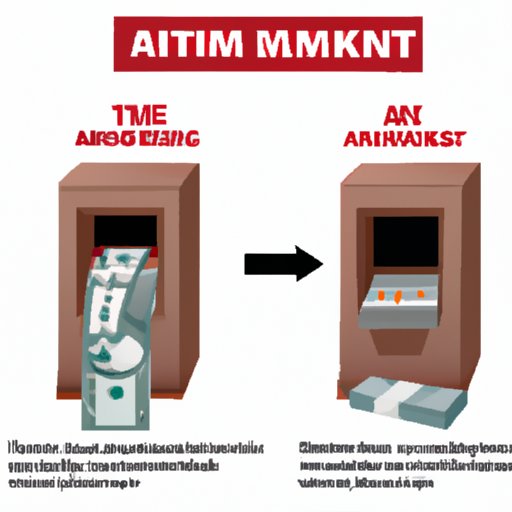
Introduction
Withdrawing money from an ATM is a convenient way to get cash, but what if the ATM withdrawal causes your account balance to drop below zero? That’s where overdraft protection comes in. This article will explore withdrawing money from ATMs with overdraft protection, including the pros and cons, tips for smart withdrawals, and important things to know before you swipe.
ATM Withdrawals with Overdraft Protection: How Does It Work?
Overdraft protection is a service offered by banks that allows transactions to go through even if there isn’t enough money in your account to cover them. When you withdraw money from an ATM, your bank may cover the transaction with overdraft protection if you have it set up.
To activate overdraft protection for ATM withdrawals, you’ll need to contact your bank and request it. Once active, you’ll typically be charged a fee for each ATM transaction that overdraft protection covers.
It’s important to note that there are conditions that must be met in order to use overdraft protection for ATM withdrawals. These conditions can vary from bank to bank but may include:
- Your account must be in good standing
- You must have had your account for a certain length of time
- You must enroll in overdraft protection
5 Pros and Cons of Using Your Overdraft Protection to Withdraw from ATMs
Using overdraft protection for ATM withdrawals can have its advantages and disadvantages. Here are five pros and cons to consider before making a decision:
Pros:
- Convenience: Overdraft protection can be a lifesaver if you need cash quickly and don’t have time to go to a bank.
- Flexibility: You can withdraw money from any ATM, not just your bank’s ATM.
- No declined transactions: Overdraft protection can prevent a transaction from being declined due to insufficient funds.
- Credit score protection: Overdraft protection can help you avoid negative marks on your credit report that can result from bounced checks or missed payments.
- No embarrassment: Overdraft protection can save you from the embarrassment of having a card declined in public.
Cons:
- High fees: Banks typically charge a fee for each ATM transaction that overdraft protection covers, which can add up quickly.
- High interest rates: Overdraft protection loans often come with high interest rates, making it more expensive to use than other forms of credit.
- Temporary fix: Overdraft protection is a temporary fix and should not be relied on as a long-term solution to financial issues.
- Easy to get trapped in an overdraft cycle: If you’re not careful, overdraft protection can lead to a cycle of debt.
- Not always guaranteed: Just because you have overdraft protection doesn’t mean the bank will always cover your transaction.
It’s essential to weigh the pros and cons of each situation before deciding to use overdraft protection for ATM withdrawals. For instance, if you’re in a tight spot and need cash immediately, overdraft protection may be worth the fees. However, if you’re trying to avoid further debt or are concerned about overspending, it may be best to avoid using overdraft protection.
Maximizing Your Overdraft Protection: Tips for Smart ATM Withdrawals
Using overdraft protection for ATM withdrawals requires careful consideration to avoid incurring fees and debt. Here are some tips for getting the most out of overdraft protection:
- Set limits: You can set up limits on how much you’ll allow yourself to withdraw with overdraft protection. This can help you avoid overspending and being stuck in an overdraft cycle.
- Understand the fees: Be aware of the fees associated with overdraft protection. This includes not only ATM transaction fees but also interest rates if you have an overdraft protection loan.
- Avoid unnecessary transactions: Only use overdraft protection for necessary transactions to avoid paying unnecessary fees; try finding other ways to cover the cost of less important items.
Comparing ATM Withdrawals with Withdrawals from a Bank Teller: Which is a Better Choice with Overdraft Protection?
While withdrawing money from an ATM may provide convenience, it’s not always the best choice, especially when utilizing overdraft protection. Here’s a quick comparison of using an ATM versus visiting a bank teller to withdraw money with overdraft protection:
- ATM withdrawals: Quick and easy, but sometimes more expensive in fees and interest rates.
- Withdrawals from a bank teller: May involve waiting in line, but less likely to incur fees and offer a chance to speak with a banking professional about your finances.
Ultimately, the best choice for using overdraft protection will depend on your unique situation. If you need access to cash immediately, an ATM may be the best option, while bank teller withdrawals can offer more personalized assistance with your finances.
Overdraft Protection and ATM Withdrawals: Important Things to Know Before You Swipe
Before you use your overdraft protection for ATM withdrawals, there are a few key points to keep in mind:
- Understand the fees: Be aware of all the fees, including ATM transaction fees, overdraft protection fees, and interest rates.
- Set limits: Set limits on how much you’ll allow yourself to withdraw with overdraft protection to avoid overspending and being stuck in an overdraft cycle.
- Avoid unnecessary transactions: Use overdraft protection only when necessary, and avoid using it for less urgent expenditures.
- Know the repayment terms: Make sure you understand the repayment terms for overdraft protection to avoid being caught off guard by unexpected payments.
Conclusion
Using overdraft protection for ATM withdrawals can offer convenience in a pinch, but it’s essential to understand the fees and implications before swiping your card. By weighing the pros and cons and following the tips outlined in this article, you can make an informed decision when using overdraft protection at an ATM.





